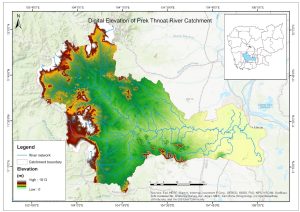Strengthening Flood and Drought Risk Management and Early Warning System in the Lower Mekong Basin of Cambodia
ABOUT PROJECT
The Higher Eductaion Improvement Project (HEIP) was approved by the Board of Directors of the World Bank on April 26, 2018 and became effective on 17 September 2018. The HEIP activities are funded by an International Development Association (IDA) Credit of US$ 90.0 million equivalent and US$2.5 million from the Royal Government of Cambodia. The project is expected to be implemented over a 6-year period – starting in July 2018 and ending in June 2024.
The project main beneficiaries include: support activities in five targeted public Higher Education Institutions (HEIs), relevant departments in the Ministry of Education, Youth and Sport (MoEYS), and selected private HEIs. The public HEIs include three within Phnom Penh – the Institute of Technology Cambodia (ITC), the Royal University of Agriculture (RUA), the Royal University of Phnom Penh (RUPP), and other two in the provinces – the Svay Rieng University (SRU) and the University of Battambang (UBB). The Phnom Penh-based public HEIs were selected because they represent the top institutes in the areas of Science, Technology, Engineering and Mathematics (STEM) and Agriculture education and research in the country. The project comprised of four components:
• Component 1: Improving Teaching and Learning in STEM and Agriculture – aims to enhance quality of teaching and learning capacity of targeted HEIs in the fields of science, technology, engineering, mathematics (STEM), and agriculture, while other complementary areas deemed necessary for economic development will also be supported.
– Sub-component 1.1: Improve Teaching and Learning
– Sub-component 1.2: Improve Institutional Capacity
• Component 2: Improving Research in STEM and Agriculture – aims to improve the quality and relevance of research in STEM and Agriculture fields by supporting the targeted HEIs in the development and implementation of research projects that result in peer reviewed publications.
• Component 3: Strengthening Sectoral Governance and Project Management – aims to strengthen the system of higher education sector to produce graduates equipped with transferable skills and knowledge, especially in STEM and Agriculture.
• Component 4: Contingent Emergency Response.
ITC is implementing only the activities of Component 1 and 2 under component 2, there are 25 sub-projects have been implementing in Round 1 and Round 2. One of these research projects entitled “Strengthening Flood and Drought Risk Management and Early Warning System in Lower Mekong Basin of Cambodia”. The specific objectives of this research project are firstly to enhance and analyze of the historical data, information and knowledge base for the management of floods and droughts, secondly to improve flood and drought forecasting and establish flood and drought warning system and thirdly to build capacity to manage drought and flood risk. This research will produces expected outputs: 1- Development of flood and drought monitoring and early warning system using real-time monitoring and hydrodynamic and drought analysis indicators, 2- Capacity development of students/researchers in managing flood and drought risk, 3- Establishment of flood and drought laboratory at ITC, 4- Research and publication on flood and drought monitoring and management, and 5- provide the supporting data and information for local people and collaborative partners to reduce natural disaster damages and for disaster mitigation and response.
OJECTIVE
The objective of the research are:
· To become a leading research laboratory and service provider recognized nationwide for our high-quality research, innovation, and contribution to society in disaster risks management, planning and policies.
· To implement research projects, consulting works related to disaster risks from water resources development, infrastructure Development, landuse and climate change induce more disaster risks in Cambodia and Mekong Region
· To produce human resources who will play important role in managing and planning/policies in disaster risks for Cambodia and the region.
STUDY AREA

The Prek Thnot River is one of the major tributaries of the Mekong River. The Prek Thnot River Basin covers six provinces (Koh Kong, Kampong Speu, Kampot, Sihanouk Ville, Takeo, Kandal, and Phnom Penh) of Cambodia. The river’s total catchment area is about 6,123.8 km², with a river length of 227 km from the Cardamom Mountains in the southwest area of Cambodia. The Prek Thnot River Basin lies between latitudes 11°00′ to 12°10′ N and longitudes 103°40′ to 105°10′ E (Fig.1) and joins into the Bassac River. This basin consists of four flow stations and eight meteorological stations. Moreover, the Prek Thnot Watershed receives an average annual rainfall of 1,104.9 mm, and the average flow is estimated to be (1997-2011). Additionally, the average streamflow of this area is estimated to be 167 m³/s. The dry season encompasses six months, November to April. During these periods, the flow typically reaches a minimum at the end of the season between February and April.
METHODOLOGY FRAMEWORK

